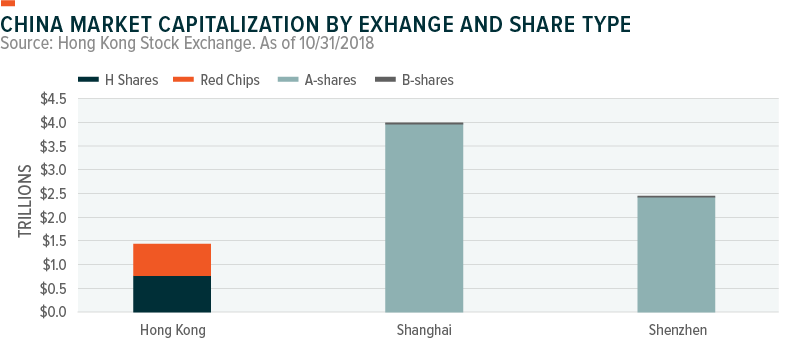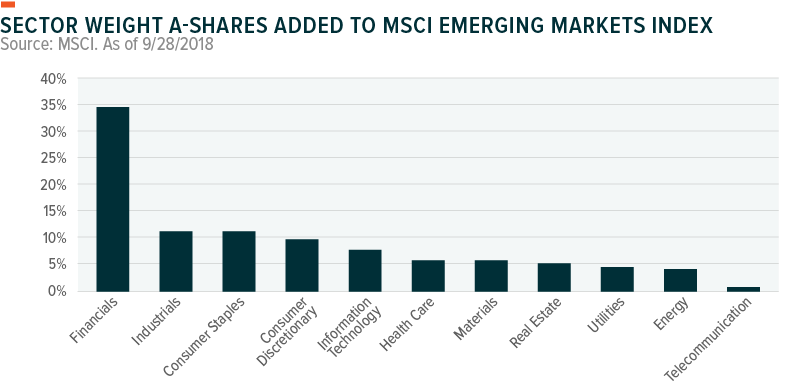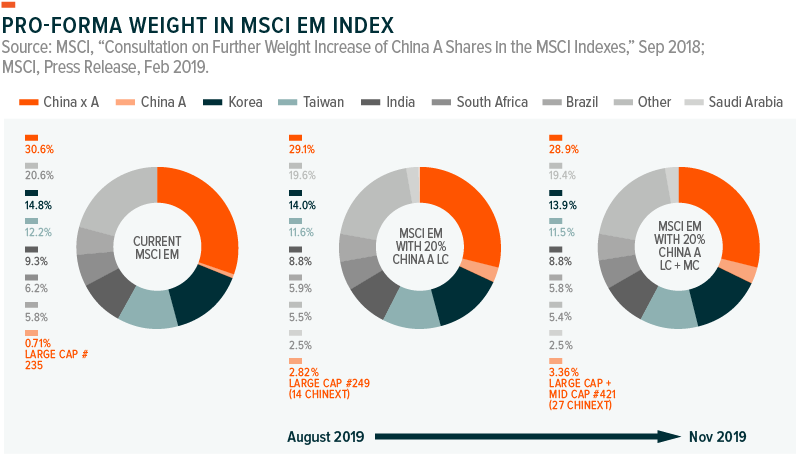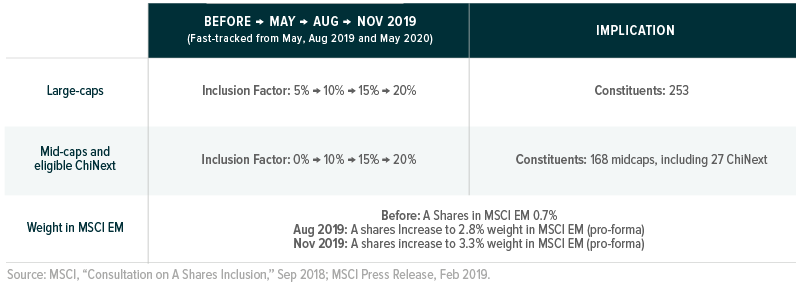Global X recently revamped its suite of China Sector ETFs. The ETFs now track MSCI China Sector indexes that incorporate all eligible Chinese equity securities, including China A, B, and H shares, Red chips, P chips, and foreign listings (such as ADRs).
This post was updated as of May 7, 2019.
A-share Overview
China ‘A shares’ are listed on domestic stock exchanges in China, in contrast to H shares, which are listed in Hong Kong. Historically, foreign investors have had difficulties accessing the A share market due to government restrictions, leading China-focused indexes and funds to focus their exposure on H shares. Yet as China continues its process of opening up to the rest of the world, A shares are becoming increasingly accessible, opening up a broad opportunity set of investable companies in China.
The A share market features over 3,500 companies with a combined market capitalization of over $6 trillion, making it one of the largest equity markets in the world. It is also considerably larger than the H share market, which is less than 250 companies and a market cap of approximately $750 billion..1

Red Chips are companies based in China but incorporated abroad and listed in Hong Kong. B shares are stocks of companies listed in China that trade in Hong Kong Dollars or US Dollars.
In 2018, MSCI began including China A shares in their global investable market indexes (GIMI), including MSCI China, Emerging Markets, and All Country World Indexes. Rather than fully including A shares at their float-adjustment market capitalization, MSCI opted for a phased approach that limited eligible companies and kept the initial inclusion to just 5% of their full weight (5% inclusion factor). On February 28th 2019, MSCI announced that it would increase and accelerate its incremental A share inclusion over the course of three stages (May, August, and November 2019), concluding in a 20% inclusion factor in November 2019. Over the next eight months, MSCI will add China A Large caps, Mid Caps, and ChiNext stocks to its indexes.
Implications of Growing A-Share Availability
Broader Opportunity Set: The inclusion of China A shares into MSCI indexes brings hundreds of companies into the fold that previously were unavailable or difficult to access by foreign investors. The majority of these companies hail from the Financials, Industrials, and Consumer Staples sectors, providing much broader and more complete representation of these segments of the Chinese economy.

China’s Increasing Weight: MSCI’s inclusion of A shares not only affects China-focused investors, but also those with exposure to the emerging markets more broadly. China currently has a 31.3% weight in the MSCI Emerging Markets Index, 0.7% of which is A shares. Given that the factor inclusion will now increase to 20%, China A shares’ weight could increase to 2.8% by August 2019 and 3.4% by November 2019, assuming no major market moves. If MSCI were to implement full inclusion, Chinese equities would constitute over 40% of the MSCI EM Index, with over 14% being A shares. Although MSCI does not have a defined plan to include 100% of A shares, their phased approach towards inclusion is likely to further scale up should China continue to ease constraints on foreign investors.
Recent Updates in China A Shares Index Inclusion
In addition to scaling up its inclusion factor of China A shares from 5% to 20% and adding a third implementation date in 2019, MSCI also plans to include the A shares of mid-cap companies, as well as those that are listed on the technology-focused ChiNext exchange. Currently, MSCI only includes large cap stocks listed on the Shanghai and Shenzhen stock exchanges that are accessible through the Stock Connect program, which allows foreign investors to buy A shares through Hong Kong. Expanding the equity universe to include ChiNext will give investors access to ~20% more of the total China A shares universe in terms of number of stocks and market capitalization.2
MSCI’s decision to increase the A shares inclusion factor is the result of meaningful improvements in China’s market accessibility, which has accelerated over the last few years and buoyed investor confidence in investing in China. Developments include increased daily limits on transactions through Stock Connect, fewer trading suspensions, and the introduction of a closing auction mechanism on the Shanghai Stock Exchange, all of which align the Chinese stock market with international standards.
Conclusion
A shares are set to becoming an increasingly important part of global equity markets as the stocks become more widely available and are added to major indexes. After MSCI’s implementation, the MSCI Emerging Markets index will on a pro-forma basis have 253 Large cap and 168 Mid Cap China A Shares, including 27 ChiNext shares. As a result, we believe complete exposure to opportunities in China, whether via broad country funds or more specific sector funds, requires the inclusion of A shares. At the same time, China is set to become an increasingly large portion of emerging market indexes. This may warrant more careful consideration of one’s access to China, including adjusting sector exposures to control for thematic opportunities, risks, and valuations.
Related ETFs: The Global X China Sector ETFs, including the Global X MSCI China Consumer Discretionary (CHIQ), MSCI China Energy (CHIE), MSCI China Financials (CHIX), MSCI China Industrials (CHII), MSCI China Materials (CHIM), and MSCI China Communication Services (CHIC). These ETFs allows investors to invest in a basket of stocks that operate in China, across the sectors referred to within each respective ETF name.
 Global X Research Team
Global X Research Team
